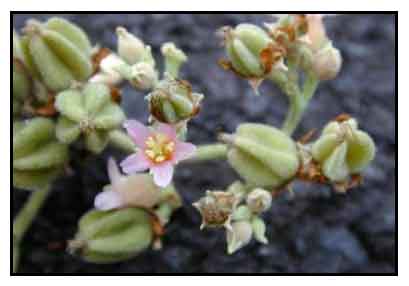 Gen info Gen info
- Melochia is a genus of flowering plants in the mallow family, Malvaceae, comprising 54 species from tropical and subtropical regions of the world.
- Melochia has been placed in the family Sterculiaceae. However, Sterculiaceae is now generally considered obsolete as a taxonomic class.
-
Etymology: The genus Melochia derives from the Arabic name Mulukhiyah, which in Arabic means mallow plants of the genus Corchorus. The specific epithet comes from the Latin umbellatus (umbel-like), referring to the inflorescence. (2)(9)
Botany
Melochia umbellata is a tree, up to 10 m tall, without buttresses. Bark is brown and generally smooth, but prominently lenticillate. Leaf is broadly egg-shaped (5 – 16 cm long and 2 – 16 cm wide), papery, and densely covered with star-shaped (stellate) hairs on both surfaces. Leaf has (3-) 5 basal veins and distinctly toothed margin. Leaf base is rounded or heart-shaped while leaf tip is short (acute to acuminate). Petiole is slender (3 – 11 cm long) and hairy. Stipules are persistent, 0.4 – 1 cm long and 0.5 – 1.2 cm wide, with pale hairs on both surfaces. Flowers are clustered into a flat-topped inflorescence (corymb), about 4 – 11 cm long, and occurs at the axillary. Flowers are pink – red, star-shaped (about 0.3 – 0.4 cm long and 1 – 1.2 cm wide) with 5 yellow stamens and a yellow style. (12)
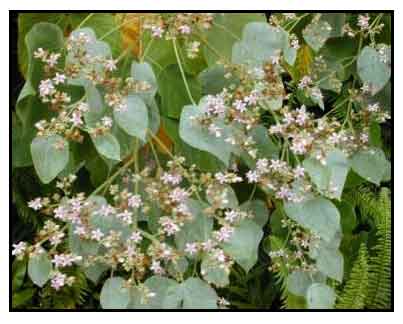 Melochia umbellata is a small tree or shrub, 2-15 m tall; young stems tomentose with stellate hairs. Leaves broadly ovate, 9-30 (-50) cm long, 3.8-15 (-27) cm long, stellate pubescent, margins irregularly crenate-serrate, base rounded to cordate, petioles 2.5-11 (-20) cm long, stipules ovate to suborbicular, 4-10 mm long, deciduous. Flowers in open corymbiform cymes, the ultimate divisions umbellate, peduncles 3-7 (-11) cm long, pedicels 1-3 mm long; calyx yellowish green to pinkish brown, the lobes deltate, 2-3.5 mm long, pubescent with stellate and also simple or forked hairs; petals pale pink to red, rarely yellow or orange-tinged, pale blue, purple, or violet, obovate to oblanceolate, 6-7 mm long; stamens of 2 lengths in different flowers, 4-5 mm long and 5.5-6.5 mm long; ovaries of 2 lengths in different flowers, 6-7 mm long and 4.5-5 mm long. Capsules green, brown, or purplish red, oblong, 8-10 mm long, incompletely septicidal, deeply grooved between carpels. Seeds brown, 2-3.5 mm long, winged" (Wagner et al., 1999; p. 1279). (8) Melochia umbellata is a small tree or shrub, 2-15 m tall; young stems tomentose with stellate hairs. Leaves broadly ovate, 9-30 (-50) cm long, 3.8-15 (-27) cm long, stellate pubescent, margins irregularly crenate-serrate, base rounded to cordate, petioles 2.5-11 (-20) cm long, stipules ovate to suborbicular, 4-10 mm long, deciduous. Flowers in open corymbiform cymes, the ultimate divisions umbellate, peduncles 3-7 (-11) cm long, pedicels 1-3 mm long; calyx yellowish green to pinkish brown, the lobes deltate, 2-3.5 mm long, pubescent with stellate and also simple or forked hairs; petals pale pink to red, rarely yellow or orange-tinged, pale blue, purple, or violet, obovate to oblanceolate, 6-7 mm long; stamens of 2 lengths in different flowers, 4-5 mm long and 5.5-6.5 mm long; ovaries of 2 lengths in different flowers, 6-7 mm long and 4.5-5 mm long. Capsules green, brown, or purplish red, oblong, 8-10 mm long, incompletely septicidal, deeply grooved between carpels. Seeds brown, 2-3.5 mm long, winged" (Wagner et al., 1999; p. 1279). (8)
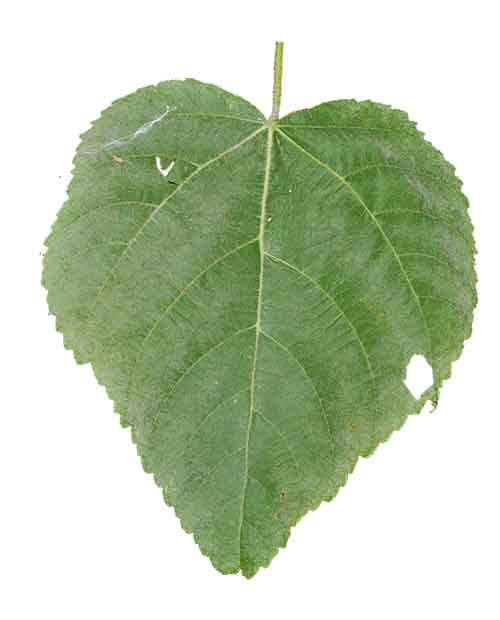 Distribution Distribution
- Native to the Philippines.
- Also native to Bangladesh, Borneo, Cambodia, Christmas Is., India, Jawa, Laos, Lesser Sunda Is., Malaya, Myanmar, New Guinea, Nicobar Is., Santa Cruz Is., Solomon Is., Sumatera, Thailand, Vietnam.
(1)
- Grows primarily in seasonally dry tropical biome.
- Cultivated in warm regions of the world as a shade tree.
- Invasive in some places.
Constituents
- Study of n-hexane extract of leaves yielded two compounds i.e., 1-tetracisanol and a steroid compound. (see study below) (3)
- Study of stem bark for secondary metabolites yielded alkaloids and triterpenoids. Isolate E is a triterpenoid group compound, while FKs and FKb are steroid group compound. (see study below)
(6)
- Study isolated stigmasterol from the stem bark of Melochia umbellata (Houtt) Stapf var. visenia. (see study below) (10)
- Study of methanol extract of Melochia umbellata var. deglabrata leaves isolated fir new quinoline alkaloids, paliasanines A-E (1-5) along with 17 known compounds (6-22). (see study below) (15)
- Study isolated two group compounds from n-hexane and chloroform extracts, namely: stigmasta-5,22-dien-3-β-ol (1) and stigmasta-5,22-dien-on (2). (see study below) (16)
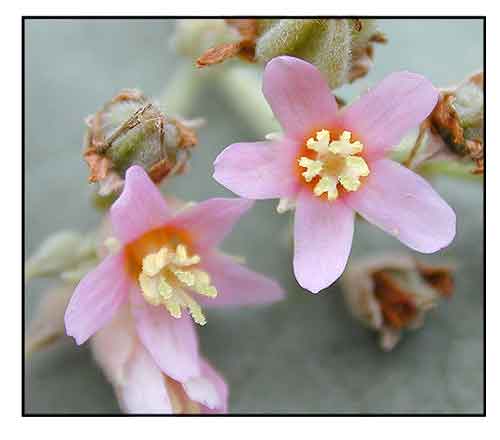 Properties Properties
- Studies have suggested antibacterial, anti-dengue, anti-tumor, antiproliferative, anti-HIV properties.
Parts used
- Leaves, roots, stem, bark.
Uses
Folkloric
- No reported medicinal use in the Philippines.
- In South Sulawesi, Indonesia, used for treatment of hepatitis, high cholesterol, diabetes, and hypertension.
Others
- Fodder: A cut-and-carry feed for ruminants.
- Wood: Used for making toys and handicrafts.
Studies
• Antibacterial / Leaves: Study evaluated various extracts of M. umbellata (Houtt.) Stapf var. K. degrabata leaves for antibacterial activity against three bacterial strains i.e., E. coli, S. aureus, and S. dysenteriae. At concentrations of 2500, 5000, 10,000 and 20,000 ppm, the N-hexane extract was most active against S. aureus with ZOI of 10.5 mm, 10.80 mm, 11.00 mm, and 11.45 mm, respectively. The ethyl acetate extract was most active against S. dysenteriae. (see constituents above) (3)
• Dengue Antiviral Activity / Cytotoxicity / Bark: Study evaluated the dengue antiviral activity on a polar bark extract of M. umbellata var Vicenia. An ethyl acetate extract was tested against A. salina and dengue virus. Results showed IC50 of 101.66 µg/ml against A. salina and IC50 of 1.67 µg against dengue virus. The toxicity to brine shrimp A. salina has a positive correlation with the dengue antivirus activity. (4) Study evaluated n-hexane and chloroform extract of Melochia umbellata stem bark powder fpr anti-dengue virus activity. The n-hexane extract yielded terpenoid, steroids, and alkaloids, while the chloroform extract contained steroids and alkaloids. Results showed very active effects of n-hexane and chloroform extracts against dengue virus with IC50s of 2.39 and 2.34 µg/ml, respectively. (14)
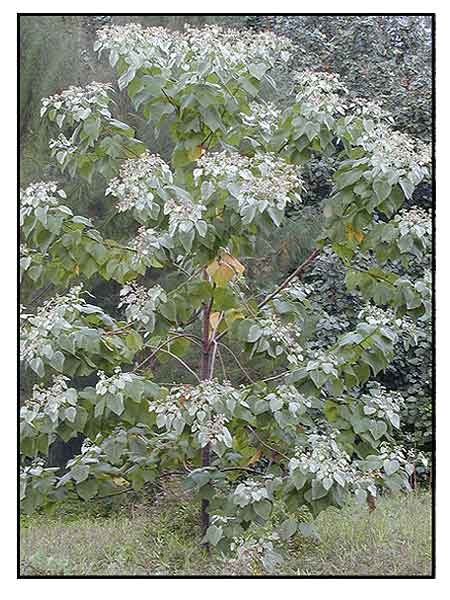 • Antibacterial / Stem Bark: A hexane extract of stem bark of M. umbellata showed highest antibacterial activity against B. subtilis with inhibitory zone diameter of 12.0 mm. Isolate D showed weak inhibitory effect on all test bacteria. FKs compound showed highest diameters of inhibition against B. subtilis and A. aureus, 18.0 mm and 13.0 mm, respectively. FKb showed highest ZOI of 12.0 mm against B. subtilis. (5) • Antibacterial / Stem Bark: A hexane extract of stem bark of M. umbellata showed highest antibacterial activity against B. subtilis with inhibitory zone diameter of 12.0 mm. Isolate D showed weak inhibitory effect on all test bacteria. FKs compound showed highest diameters of inhibition against B. subtilis and A. aureus, 18.0 mm and 13.0 mm, respectively. FKb showed highest ZOI of 12.0 mm against B. subtilis. (5)
• Methyl ß-(p-hydroxyphenyl( Acrylic Compound / Antitumor / Root Bark: Study of root bark yielded methyl ß-(p-hydroxyphenyl) acrylic. The compound was evaluated for antitumor activity using P-388 murine leukemia cell. Results showed high antitumor activity with IC50 of 5.35 µg/mL. (6)
• Anti-Dengue Virus / Stigmasterol / Stem Bark: Study isolated stigmasterol from the stem bark of Melochia umbellata (Houtt) Stapf var. visenia. The stigmasterol exhibited potential as a dengue antiviral agent with IC50 of 9.11 µg/mL. (10)
• Antifungal / Stigmasterol / Root Wood: Study isolated a stigmasterol glycoside from the root wood of M. umbellata var. deglabrata. The isolate showed activity against Aspergillus niger. (11)
• Antibacterial / Endophytic Fungi / Leaves and Twigs: Study isolated 12 species of endophytic fungi from leaves and twigs of M. umbellata. Four showed activity in the antagonistic test against Escherichia coli, Pseudomonas aeruginosa, Vibrio cholerae, and Shigella dysenteriae. Ethyl acetate and methanol extracts showed inhibition zones between 0 and 10.51 mm. Active extracts contained alkaloids, flavonoids, and steroids. Results suggest the endophytic fungi could be a promising source of bioactive compounds. (13)
• Paliasanine Alkaloids / Antiproliferative / Anti-HIV / Leaves: Study of methanol extract of Melochia umbellata var. deglabrata leaves isolated fir new quinoline alkaloids, paliasanines A-E (1-5) along with 17 known compounds (6-22). Compounds 6 and 7 displaced selective cytotoxicity (IC50 5.9-8.4 µM) against A549 and MCF-7 cell lines. Compounds 1-3 did not exhibit anti-HIV effect in MT4 cells, although related quinolone derivative waltherione A showed significant activity. Results suggest 3-methoxy-4-quinolone skeleton may have potential antiproliferative and anti-HIV activities. (15)
• Cytotoxicity Against Shrim Larvae / Stem Bark: Study isolated two group compounds from n-hexane and chloroform extracts, namely: stigmasta-5,22-dien-3-β-ol (1) and stigmasta-5,22-dien-on (2). Compound 1 showed weak toxicity activities against Artemia salina (LC50 548.48 µg/mL, while compound 2 exhibited higher inhbitory activity with LC50 of 410.81 µg/mL. (16)
• Antimicrobial / Anti-HCV / Triterpenoid and Alkaloid Compounds: Study of M. umbellata var visenia isolated two compounds, namely: 3-acetyl-12-en-28-oic acid (1) and (R)-N-trans-feruloyloctopamine (2) and were tested for antimicrobial and anti-HCV activities. Antimcrobial assay of compounds 1 and 2 showed moderate to active zones of inhibition against E. coli (8.4 and 7.0mm), S. typhi (11.2 and 10.55mm), S. aureus (10.8and 9.1mm), and Candida albicans (8.5 and 7.9mm) respectively. Anti-HCV tests on the two compounds showed IC50s of 52.07 and 45.02 µg/mL, respectively. (17)
• Waltherione C and Cleomiscosin / Cytotoxicity / Dried Heartwood: Study reports on the isolation of a quinoline alkaloid, walterione C and a coumarinolignan, cleomiscosin A. In brine shrip lethality assay, the compounds showed LC50s of 0.29 µg/mL and >1000 µg/mL, respectively. Waltherione C has been reported to have anti-HIV activity (EC50 0.3 µg/mL) and toxicity against CEM-TART cells (LC50 3.8 µg/mL) and cytotoxicity against P-388 murine leukema cells (IC50 0.26 µg/m. (18)
Availability
Wild-crafted.
|

![]()



 Gen info
Gen info



